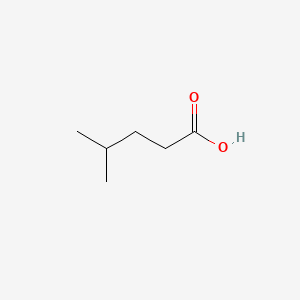| MeSH term | MeSH ID | Detail |
|---|---|---|
| Clostridium Infections | D003015 | 5 associated lipids |
| Diarrhea | D003967 | 32 associated lipids |
| Anemia, Sickle Cell | D000755 | 34 associated lipids |
| Occupational Diseases | D009784 | 42 associated lipids |
| Diabetes Mellitus, Type 1 | D003922 | 56 associated lipids |
| Diabetes Mellitus, Type 2 | D003924 | 87 associated lipids |
| Edema | D004487 | 152 associated lipids |
4-METHYLPENTANOIC ACID
4-METHYLPENTANOIC ACID is a lipid of Fatty Acyls (FA) class. The involved functions are known as CoA-transferase activity. 4-methylpentanoic acid often locates in Cytosol. The related lipids are Fatty Acids and alpha-ketocaproic acid.
Cross Reference
Introduction
To understand associated biological information of 4-METHYLPENTANOIC ACID, we collected biological information of abnormalities, associated pathways, cellular/molecular locations, biological functions, related genes/proteins, lipids and common seen animal/experimental models with organized paragraphs from literatures.
What diseases are associated with 4-METHYLPENTANOIC ACID?
There are no associated biomedical information in the current reference collection.
Possible diseases from mapped MeSH terms on references
We collected disease MeSH terms mapped to the references associated with 4-METHYLPENTANOIC ACID
PubChem Associated disorders and diseases
What pathways are associated with 4-METHYLPENTANOIC ACID
There are no associated biomedical information in the current reference collection.
PubChem Biomolecular Interactions and Pathways
Link to PubChem Biomolecular Interactions and PathwaysWhat cellular locations are associated with 4-METHYLPENTANOIC ACID?
Visualization in cellular structure
Associated locations are in red color. Not associated locations are in black.
Related references are published most in these journals:
| Location | Cross reference | Weighted score | Related literatures |
|---|
What functions are associated with 4-METHYLPENTANOIC ACID?
Related references are published most in these journals:
| Function | Cross reference | Weighted score | Related literatures |
|---|
What lipids are associated with 4-METHYLPENTANOIC ACID?
Related references are published most in these journals:
| Lipid concept | Cross reference | Weighted score | Related literatures |
|---|
What genes are associated with 4-METHYLPENTANOIC ACID?
There are no associated biomedical information in the current reference collection.
What common seen animal models are associated with 4-METHYLPENTANOIC ACID?
There are no associated biomedical information in the current reference collection.
NCBI Entrez Crosslinks
All references with 4-METHYLPENTANOIC ACID
Download all related citations| Authors | Title | Published | Journal | PubMed Link |
|---|---|---|---|---|
| Halvatsiotis PG et al. | Insulin effect on leucine kinetics in type 2 diabetes mellitus. | 2002 | Diabetes Nutr. Metab. | pmid:12173727 |
| Elphick LM et al. | Conserved valproic-acid-induced lipid droplet formation in Dictyostelium and human hepatocytes identifies structurally active compounds. | 2012 | Dis Model Mech | pmid:22003123 |
| Gray BP et al. | Analysis of methyloxime derivatives of intact esters of testosterone and boldenone in equine plasma using ultra high performance liquid chromatography tandem mass spectrometry. | 2011 | Drug Test Anal | pmid:21287693 |
| Wu H et al. | Toxicological effects of environmentally relevant lead and zinc in halophyte Suaeda salsa by NMR-based metabolomics. | 2012 | Ecotoxicology | pmid:22926641 |
| Tallová J and Stárka L | Effect of 4-cholesten-3-one on 3 beta-hydroxysteroid dehydrogenase activity in rat adrenals. | 1984 | Endocrinol. Exp. | pmid:6333334 |
| Fang HH et al. | Effects of Mo(VI) on phototrophic hydrogen production by Rhodobacter sphaeroides. | Environ Technol | pmid:21970170 | |
| Colombo D et al. | Anti-tumor-promoting activity of simple models of galactoglycerolipids with branched and unsaturated acyl chains. | 2005 | Eur J Med Chem | pmid:15642411 |
| Guarnieri A et al. | [Non-steroidal anti-inflammatory agents. VI. Optically active 3-(4-biphenylyl)-3-oxybutyric, valerianic, caproic and isocaproic acids]. | 1978 | Farmaco Sci | pmid:744247 |
| Rammouz G et al. | Oxidative Stress-Mediated Brain Dehydroepiandrosterone (DHEA) Formation in Alzheimer's Disease Diagnosis. | 2011 | Front Endocrinol (Lausanne) | pmid:22654823 |
| Kinross JM et al. | Gut microbiome-host interactions in health and disease. | 2011 | Genome Med | pmid:21392406 |
